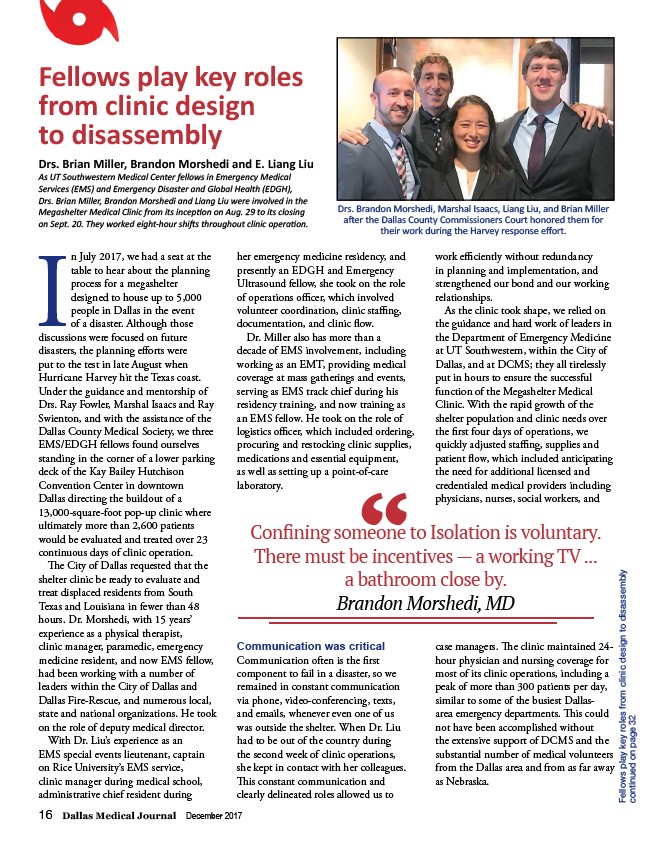
Fellows play key roles
from clinic design
to disassembly
Drs. Brian Miller, Brandon Morshedi and E. Liang Liu
n July 2017, we had a seat at the
table to hear about the planning
process for a megashelter
designed to house up to 5,000
people in Dallas in the event
of a disaster. Although those
discussions were focused on future
disasters, the planning eff orts were
put to the test in late August when
Hurricane Harvey hit the Texas coast.
Under the guidance and mentorship of
Drs. Ray Fowler, Marshal Isaacs and Ray
Swienton, and with the assistance of the
Dallas County Medical Society, we three
EMS/EDGH fellows found ourselves
standing in the corner of a lower parking
deck of the Kay Bailey Hutchison
Convention Center in downtown
Dallas directing the buildout of a
13,000-square-foot pop-up clinic where
ultimately more than 2,600 patients
would be evaluated and treated over 23
continuous days of clinic operation.
Th e City of Dallas requested that the
shelter clinic be ready to evaluate and
treat displaced residents from South
Texas and Louisiana in fewer than 48
hours. Dr. Morshedi, with 15 years’
experience as a physical therapist,
clinic manager, paramedic, emergency
medicine resident, and now EMS fellow,
had been working with a number of
leaders within the City of Dallas and
Dallas Fire-Rescue, and numerous local,
state and national organizations. He took
on the role of deputy medical director.
With Dr. Liu’s experience as an
EMS special events lieutenant, captain
on Rice University’s EMS service,
clinic manager during medical school,
administrative chief resident during
her emergency medicine residency, and
presently an EDGH and Emergency
Ultrasound fellow, she took on the role
of operations offi cer, which involved
volunteer coordination, clinic staffi ng,
documentation, and clinic fl ow.
Dr. Miller also has more than a
decade of EMS involvement, including
working as an EMT, providing medical
coverage at mass gatherings and events,
serving as EMS track chief during his
residency training, and now training as
an EMS fellow. He took on the role of
logistics offi cer, which included ordering,
procuring and restocking clinic supplies,
medications and essential equipment,
as well as setting up a point-of-care
laboratory.
Communication was critical
Communication often is the fi rst
component to fail in a disaster, so we
remained in constant communication
via phone, video-conferencing, texts,
and emails, whenever even one of us
was outside the shelter. When Dr. Liu
had to be out of the country during
the second week of clinic operations,
she kept in contact with her colleagues.
Th is constant communication and
clearly delineated roles allowed us to
16 Dallas Medical Journal December 2017
work effi ciently without redundancy
in planning and implementation, and
strengthened our bond and our working
relationships.
As the clinic took shape, we relied on
the guidance and hard work of leaders in
the Department of Emergency Medicine
at UT Southwestern, within the City of
Dallas, and at DCMS; they all tirelessly
put in hours to ensure the successful
function of the Megashelter Medical
Clinic. With the rapid growth of the
shelter population and clinic needs over
the fi rst four days of operations, we
quickly adjusted staffi ng, supplies and
patient fl ow, which included anticipating
the need for additional licensed and
credentialed medical providers including
physicians, nurses, social workers, and
case managers. Th e clinic maintained 24-
hour physician and nursing coverage for
most of its clinic operations, including a
peak of more than 300 patients per day,
similar to some of the busiest Dallasarea
emergency departments. Th is could
not have been accomplished without
the extensive support of DCMS and the
substantial number of medical volunteers
from the Dallas area and from as far away
as Nebraska.
As UT Southwestern Medical Center fellows in Emergency Medical
Services (EMS) and Emergency Disaster and Global Health (EDGH),
Drs. Brian Miller, Brandon Morshedi and Liang Liu were involved in the
Megashelter Medical Clinic from its incepti on on Aug. 29 to its closing
on Sept. 20. They worked eight-hour shift s throughout clinic operati on.
Drs. Brandon Morshedi, Marshal Isaacs, Liang Liu, and Brian Miller
aft er the Dallas County Commissioners Court honored them for
their work during the Harvey response eff ort.
Fellows play key roles from clinic design to disassembly
continued on page 32
I
“ Confi ning someone to Isolation is voluntary.
There must be incentives — a working TV ...
a bathroom close by.
Brandon Morshedi, MD